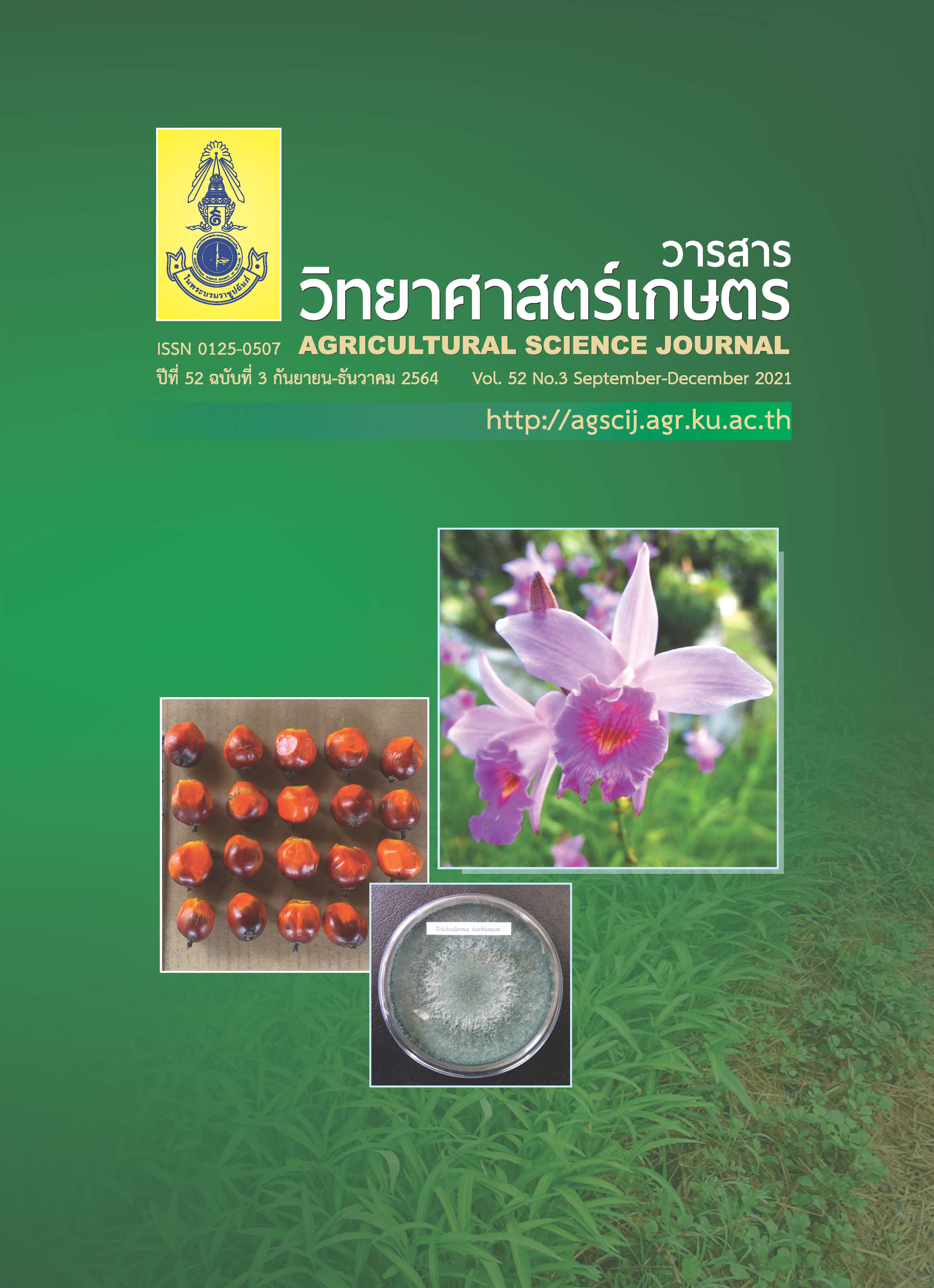Water Quality and Phytoplankton Diversity of Rattanai Reservoir Khaokho District, Petchabun Province
Main Article Content
Abstract
The Rattanai Reservoir is used in many ways and a source of wastewater from households and surrounding resorts. This may affect water quality change to be unsuitable for uses and affect phytoplankton in the water resource. This study aimed were to evaluate water quality and diversity of phytoplankton by collecting water samples and analyzing them for quality, cadmium content, and lead content, and to characterize the diversity of phytoplankton in each season of the year. Data were collected from 3 stations, twice a season. The results revealed that water quality in all seasons were similar. During the year, the range was from 5.10–9.48 mg/L for dissolved oxygen content, 24.2–27.7°C for temperature, 7.0–7.7 for pH, 0
mg/L for ammonia, 38–44 mg/L as CaCO3 for alkalinity, 16.57–18.45 Pt-Co Unit for color, 55–76 mg/L for solid content, 8.09–12.36 NTU for turbidity, 140–175 MPN/100 mL for coliforms bacteria values, and cadmium and lead were not detected in the water sources. The water quality was
categorized as the standard for surface water quality class 2, which indicated possibility to be utilized for consumption. Four divisions (a total of 19 genus) of phytoplankton was found, i.e., Chlorophyta, Bacillariophyta, Cyanophyta and Euglenophyta. The diversity of plankton was largest in summer season, followed by winter and rainy seasons, respectively. Therefore, water in the Rattanai Reservoir (Khaokho district, Petchabun province) could be used for consumption (if they be sterilized or treated) and for agricultural productions.
Article Details

This work is licensed under a Creative Commons Attribution-NonCommercial-NoDerivatives 4.0 International License.
References
Agency for Toxic Substances and Disease Registry. 2007. Toxicological profile for lead. Available Source: http://www.atsdr.cdc.gov/toxfaq.html, December 9, 2021. (in Thai)
American Public Health Association, American Water Works Association, Water Environment Federation. 2005. Standard Methods for the Examination of Water and Wastewater. 20th edition. American Public Health Association, Washington, D.C., USA.
Bold, H.C. and M.J. Wynne. 1978. Introduction to the Algae: Structure and Reproduction. Prentice Hall, New Delhi, India. 706 pp.
Desikachary, T.V. 1959. Cyanophyta. Indian Council of Agricultural Research, New Delhi, India. 686 pp.
Feist, B., B. Mikula, K. Pytlakowska, B. Puzio and F. Buhl. 2008. Determination of heavy metals by ICP-OES and F-AAS after preconcentration with 2, 2′-bipyridyl and erythrosine. J. Hazard. Mater. 152(3): 1122–1129.
Gajaseni, N. 1996. Practical Guide Freshwater Ecology. Department of Biology, Faculty of Science, Chulalongkorn University, Bangkok, Thailand. 136 pp. (in Thai)
Jaisa-ard, P. 2001. Study on Protozoan Species as Water Quality Index in Bung Borapet, Nakhon Sawan Province. Research Report. Faculty of Science and Technology, Nakhon Sawan Rajabhat University. 150 pp. (in Thai)
Kelly, M.G. and E.Y. Haworth. 2002. Bacillariophyta – the diatoms, pp. 273–277. In D. John, B.A. Whitton and A.J. Brook, eds. The Freshwater Algal Flora of the British Isles. Cambridge University Press, Cambridge, England.
Kotchasenee, J. 1997. Ecology. Chulalongkorn University Press, Bangkok, Thailand. (in Thai)
Ministry of Tourism and Sport. 2021. Rattanai Reservoir. Available Source: https://thailandtourismdirectory.go.th/th/attraction/3645, December 12, 2021. (in Thai)
Panapawutkul, P. 2006. Heavy metals: the cause of environmental problems. Available Source: http://www.chemtrack.org/News-Detail.asp?TID=4&ID=7, December 9, 2021. (in Thai)
Peerapormpisal, Y. 2015. Freshwater Algae in Thailand. Department of Biology, Faculty of Science, Chiang Mai University, Chiang Mai, Thailand. (in Thai).
Pichitkul, P. 2006. Water quality in Nong Plalai Reservoir, pp. 341–348. In Proc. the 44th Kasetsart University Annual Conference: Fisheries, 30 January – 2 February 2006. Kasetsart University, Bangkok, Thailand. (in Thai)
Pollution Control Department. 1994. Water Quality Standards in Surface Water Sources. Announcement of the National Environment. Ministry of Natural Resources and Environment, Bangkok, Thailand. (in Thai)
Pollution Control Department. 1995. Criteria for Water Quality and Water Quality Standards in Thailand. Announcement of the National Environment. Ministry of Natural Resources and Environment, Bangkok, Thailand. 175 pp. (in Thai)
Proongkiat, T. 1999. Diversity of Phytoplankton and Water Quality in the Reservoir of Mae Ngat Somboonchol Dam. MS Thesis, Chiang Mai University, Chiang Mai. (in Thai)
Royal Irrigation Department. 2009. Operation Summary of Rattanai Reservoir. Phetchabun Provincial Irrigation Office. Regional Irrigation Office 10. Ministry of Agriculture and Cooperatives, Bangkok, Thailand. (in Thai)
Sanethaweesuk, S. 2010. Phytoplankton Diversity and Water Quality of Sirindhorn Dam Reservoir in Ubon Ratchathani Province. MS Thesis, Ubon Ratchathani Rajabhat University, Ubon Ratchathani. (in Thai)
Thai Meteorological Department. 2014. Season. Available Source: https://www.tmd.go.th/info/info.php?FileID=23, September 26, 2021. (in Thai)
Thummikkaphong, S., A. Koonkaew and P. Kaewkrom. 2007. Abundance and Diversity of Plankton in Pasak River at Muang District, Phetchabun Province. Research Report. Phetchabun Rajabhat University, Phetchabun, Thailand. (in Thai)
Wong-anurakchai, N. 2017. Designing and Planning Surveys to Collect Samples of Groundwater and Surface Water. United Analyst and Engineering Consultant Co., Ltd., Bangkok, Thailand. 53 pp. (in Thai)
Wongrat, L. 1999. Phytoplankton. Kasetsart University Press, Bangkok, Thailand. 851 pp. (in Thai)
Wongrat, L. 2000. Phytoplankton. Kasetsart University Press, Bangkok, Thailand. (in Thai)
Wongwilai, P. 2020. Contamination source “lead” in daily life that we may unexpected. Available Source: https://www.sanook.com/health/20553/, December 9, 2021. (in Thai)
Yossan, S. and P. Moonsin. 2015. Using dominant phytoplankton as a bioindicator of water quality in Huay Samran, Sisaket province. KMUTT R&D Journal. 38(3): 295–309. (in Thai)


